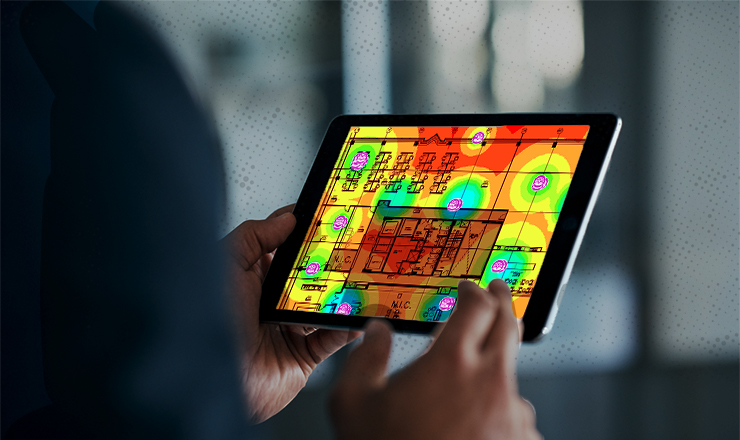
If you have enterprise Wi-Fi coverage issues then you’ve got drama. Customers and employees complaining. Productivity grinding to a halt. IT teams being cornered like frightened animals. You can squash all that drama by conducting wireless site surveys and using their outputs to design around gaps in coverage and strengthen your WLAN.
Then practice self-care, and get the boss network you deserve.
Types Of Wireless Site Surveys
Wireless site surveys come in active and passive forms. Active means you’re actively connecting to the network. Passive means the surveyor is ‘strolling past’ (without connecting) to see what kind of signals they can pick up. The results from both types of surveys can create a complete picture of your network and help you plan.
1) Active survey — Determines “What Is”
During an active survey, you’re ‘actively connecting’ to the network to read results. A field technician will walk through your environment with a laptop and use modeling software to populate a heat map that shows coverage density. This is the most accurate form of checking wireless signals and coverage. It’s also the most expensive due to the time it takes to conduct. This type of survey takes into consideration actual traffic details, like throughput speed. Passive surveys don’t provide this kind of focused information.
2)Passive survey — Determines “What is…from a distance”
During a passive survey, a field technician will come into the environment but not connect to the network. They’ll then take various speed test readings while connected to various access points (APs) throughout the building to get an average confirmation of wireless coverage. This type of wireless site survey is used to assess your layout, find areas of improvement, and plug those pesky gaps in your coverage.
3) Predictive Site Survey — Determines “What Will Likely Be”
In this type of survey, a field technician marks up a wireless site plan with existing AP locations and then uses software to determine what kind of coverage you’ll have on the network. This type of survey is proactive and typically used to plan for the best results and avoid noob mistakes.
New Construction & Site Surveys
In the case of a new building with a new network, a predictive site survey will bring clarity to the landscape – both the IT and the human components – in order to provide the best possible wireless coverage. It can help you decide things like where desks and other furniture should be placed as well as how many people (and APs!) should be put into which spaces.
Think of it as Feng Shui for your WLAN.
What Happens Next?
Once your surveys are completed, the design work begins.
Your IT provider should validate their design by repeating the predictive survey until the results show that they’ve designed a network with ideal coverage. That design is then turned into a document that they’ll share with you to show you what is needed– including any new equipment to support the design. Once the newly-designed network has been installed, your provider should conduct heat-mapping to confirm coverage.
What Does The Site Survey Show Me?
The outputs from the survey give your IT team a clear roadmap of your problems and opportunities and help to determine how to get 100% gapless high-speed coverage for your entire network.
In the case of a predictive site survey, it’s going to show you:
- Where to put your people and how many to have in each area
- How to position furniture & infrastructure
- Where to install your access points
All site surveys can help identify mistakes and oversights that will negatively impact network coverage:
- Lack of or improper placement of APs
- Network bottlenecks
- Security issues
- Access issues
- Misuse of your network by employees or IoT devices
- Inventory -what you have (machines, devices, etc.)
- Devices that are not working
Finally, acting on your wireless site survey results will solve these network problems:
- Slow or low speeds
- Lowered productivity
- Dead spots
- File sharing issues
- Guest access
- Security loopholes
- Frustrated users/guests
Conducting Your Wireless Site Survey
We recommend conducting site surveys on a live network during peak usage times. This will give us the best picture of the key metrics needed to determine utilization vs. coverage. The larger your building, the longer this will take, but we do get the results back very quickly—in the case of heat-mapping we can show turnaround results in just 24 hours.
When considering which type of survey is best, you’ll want to consider:
- Goals For Wi-Fi Coverage
- Budget
- Size of Your Network
- Level of Detail Required
Speaking of detail, depending on the site survey you choose, we can report out on the following:
- Types of switches and how many
- Number of available switch ports
- Number & position of APs -including the ones that are hidden in ceiling tiles (been there, seen that)
- Your firewall make & model
- Hidden and exposed SSIDs
- Signal strength and coverage for key areas
- Speed of connection for key areas
Getting Your Results Quickly
Been a while since your last wireless site survey? The technologies we use today have greatly improved provide us with faster, more accurate results than ever before.
They’re not quite a home pregnancy test, but the results can be just as exciting.
As a matter of fact, if you’re working with us, you can get the results from certain types of wireless site surveys in real-time.
Our technicians can submit their findings while onsite and upload them to your client portal for a quick internal review.
Enough drama already. Get in touch with us to find out how we can help you design and deploy a network that fully supports your business goals.

